
Everything in this slideshow
-
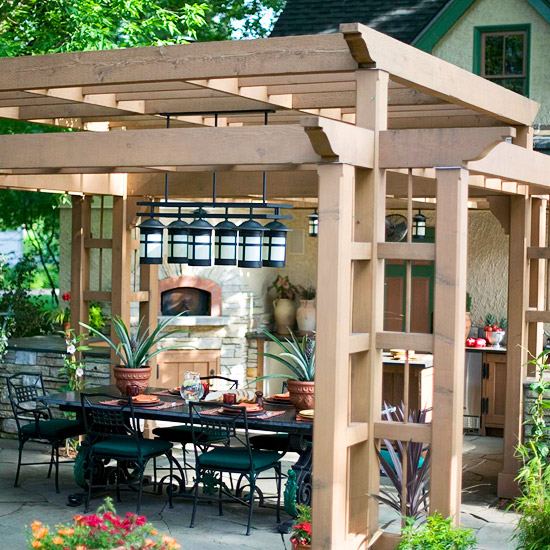
Pretty As a Picture
A subtle shift in height offers visual variety to a pergola.
- With a site close to the house, wiring for electricity may be easier; here, a wire running from the house provides power to lights hung at strategic locations.
- If most of the area underneath a pergola is paved, containers can offer a good growing spot for plants
- Varying roof heights in a pergola can define outdoor spaces. Here, a lower section indicates a transition to more open space in a yard.
- If a pergola is intended for climbing vines, smaller openings or structural elements should be included in order to allow the plants room to ramble.
- Pergolas can also be integrated with other hardscape elements; two of this structure’s corners provide edge pieces for kitchen areas.
- Learn how to use landscape structures and design as well as plants to keep your landscape secure.
-
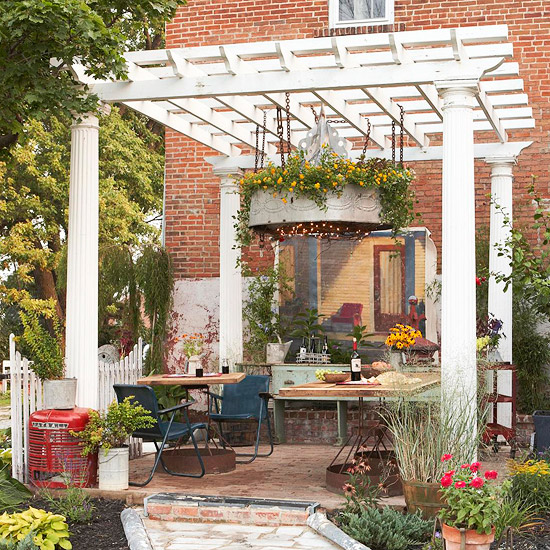
A Pergola with Personality
An imposing pergola soars over its whimsically designed space.
- Asymmetry can offer an interesting style counterpoint to a pergola; here, one side is open while another is bordered by a stretch of lattice fence.
- Part sculpture, part light fixture, a massive overhead structure offers support for illumination and blooms.
- Flowerbeds soften the geometric edges of the paved area under the pergola.
- The back of the house provides a wall for the pergola and a spot for a bit of impromptu art, too.
- Elevating a pergola and its paved surface up even just a bit gives the structure a distinct presence in the landscape.
-
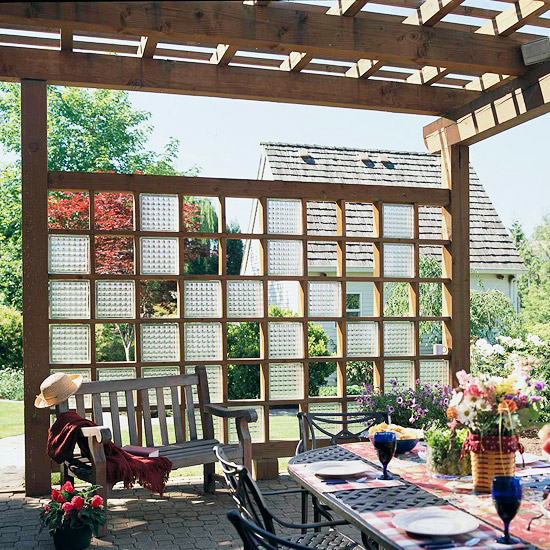
Block Party
An inventive use of an off-the-shelf material embellishes a pergola.
- Most pergolas are made from wood, but unusual materials are a welcome design addition. Here, a random pattern of glass block adds visual variety.
- Open squares in the wall provide a way for air to circulate under and through the pergola.
- Small paving stones create a patio as well as elevate the wood structure off the ground.
- Multiple entry points into the pergola direct circulation around and through the structure.
- Beams and support pieces form a trellis that offers a bit of shade on sunny days.
-
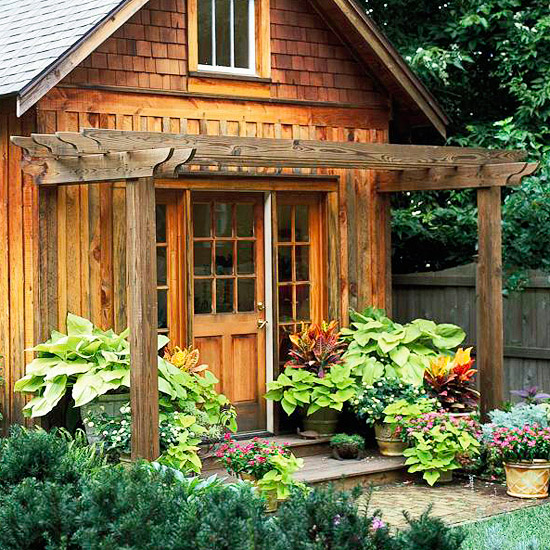
A Natural Extension
A shed and a pergola go hand in hand.
- Pergolas can be stand-alone or attached structures; this small-scale version extends off a charming wood garden shed.
- Even compact pergolas can offer seating and open-air shelter; this concrete pad underfoot is perfect for a small table and chairs.
- A pergola also offers visual relief to a building’s facade; this one breaks up the front of the shed.
- A pergola’s design can be fairly simple — here, the pergola is constructed from two 4x4s and eight 2x4s with decorative notches cut out of the ends.
- If you don’t plan on growing plants on the pergola, you will find it easier to refinish the structure later.
-
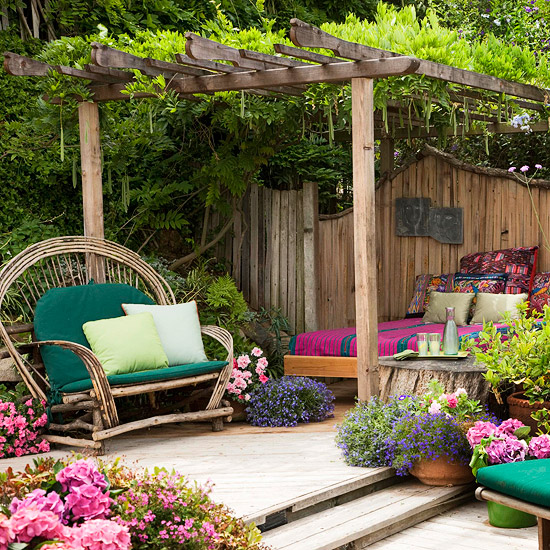
Rest Easy
A pergola provides a place to catch some shut-eye.
- Most pergolas are freestanding and usually separated from other structures. This one straddles a fence for a more nonchalant addition to a yard.
- While not a part of the pergola, the fence functions as a back wall. Its curving top adds to the structure’s carefree vibe.
- Lush wisteria shields the pergola from above.
- Many pergolas provide cover for a table or chairs. This one takes relaxation to a new level with a bed for unwinding.
- Big hydrangea blooms soften the deck space under the pergola.
-
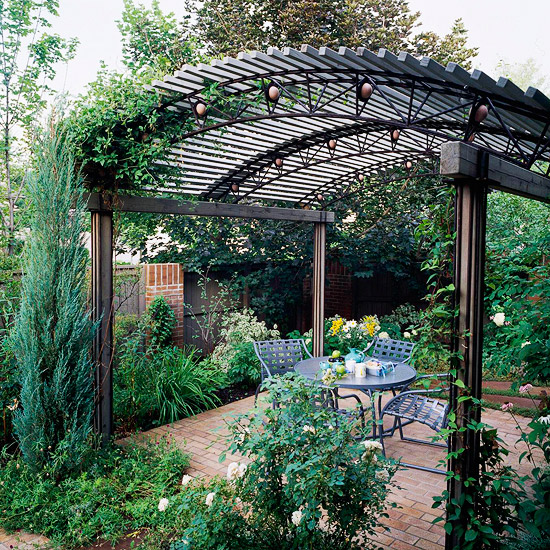
Casual Curves
An undulating roof offers visual variety for a pergola.
- Short intervals between roof materials equal more shade for the space underneath the pergola.
- A gentle roof curve provides a departure from the typical horizontal cover of most pergolas.
- Vines can be trained up columns, but tall, narrow evergreens offer a way to integrate greenery with the vertical elements.
- To create quiet, secluded space, a border of plants on three sides separates the structure from the rest of the yard.
- A simple running bond pattern of pavers provides a roomy seating space.
-
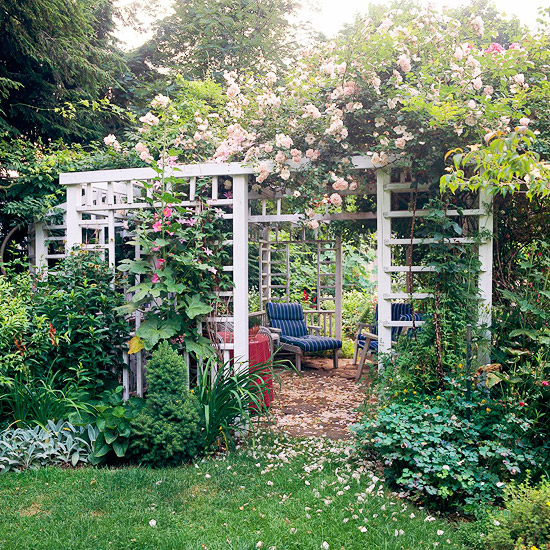
A Roof of Roses
A riotous collection of climbing roses adorns this pretty pergola.
- If plants aren’t intended for a pergola, painted wood poses less of a challenge. But if climbers will grow on and over the structure, consider a material such as composite wood that doesn’t require repainting.
- Prevent the base of the pergola from rotting, by placing beams and posts into concrete footers.
- A variety of vertical and horizontal crosspieces dresses up the structure’s sides.
- Several entrance paths into the structure enable it to serve as a gateway to separate parts of the garden.
- Lush growers such as this climbing rose need a sturdy support system: Make sure construction of the pergola can bear the plants’ weight.
- Learn more about climbing roses.
-
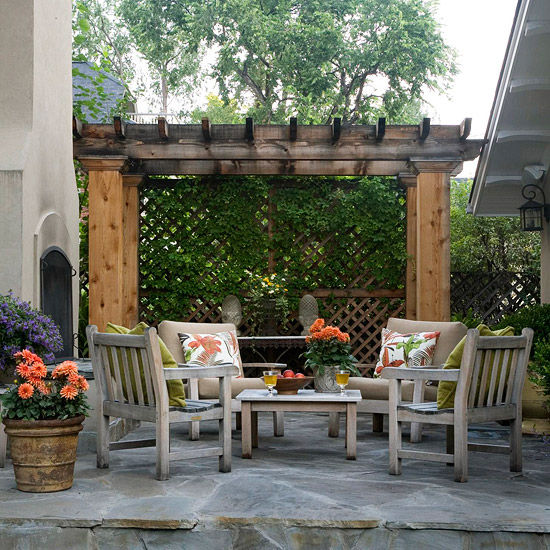
Pass-Through Pergola
Functioning more as walkway than spot for repose, a pergola adds drama to a yard.
- If a pergola backs up to a neighboring yard, enclose one side with trellis or another semi-transparent wall.
- A pergola here bridges the space between the house and fireplace.
- Centered on the trellised wall, a flowering window box adds a pop of color to the structure.
- Pergolas work well on their own, but they also can add height to an outdoor space.
- In addition to shielding views, the trellised section of the pergola provides a good spot for climbing vines.
-
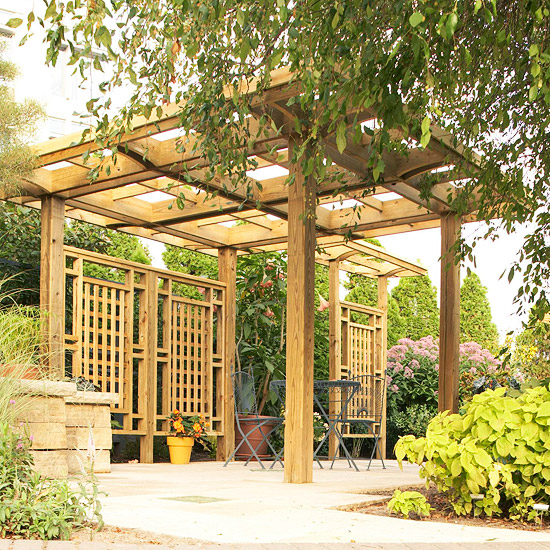
Skyward View
A pergola’s roof seems to take flight atop grand supports.
- Contrasting construction and viewpoints from the four sides of this pergola offer a multitude of ways of experiencing the structure.
- The pergola’s back wall provides design inspiration for trellising.
- Oversize beams balance the soaring roof.
- A raised bed to one side supplies spur-of-the-moment seating.
- No vines on the pergola’s roof are needed, thanks to a large shade tree nearby.
-
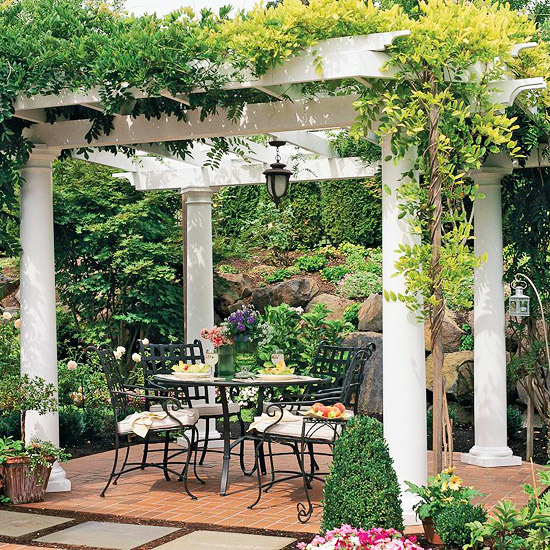
Traditional Grace
Elegant elements dress up the simple design of this pergola.
- Stately columns add classic style to this pergola.
- If an overhead fixture is wired to electricity, have the on/off switch placed at a convenient access location.
- Varying the paving material — one pattern and size under the pergola, another variety in a nearby path — helps the space from becoming a boring, uninterrupted block.
- Trained up a nearby post, a wisteria covers the pergola in green and, during summertime, purple blooms.
- A view toward a landscape isn’t always necessary for a pergola. Here, one view casts an eye toward an impressive sloped wall with boulders, shrubs, and groundcover.
- Learn more about wisteria.
-
